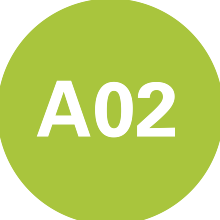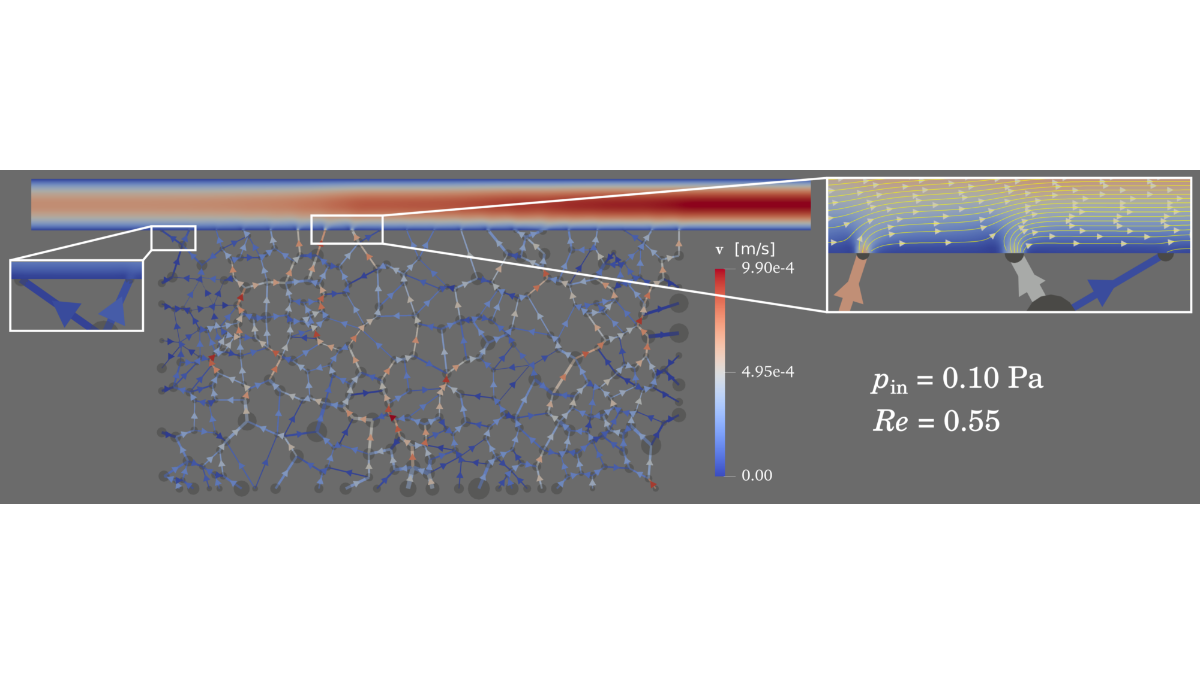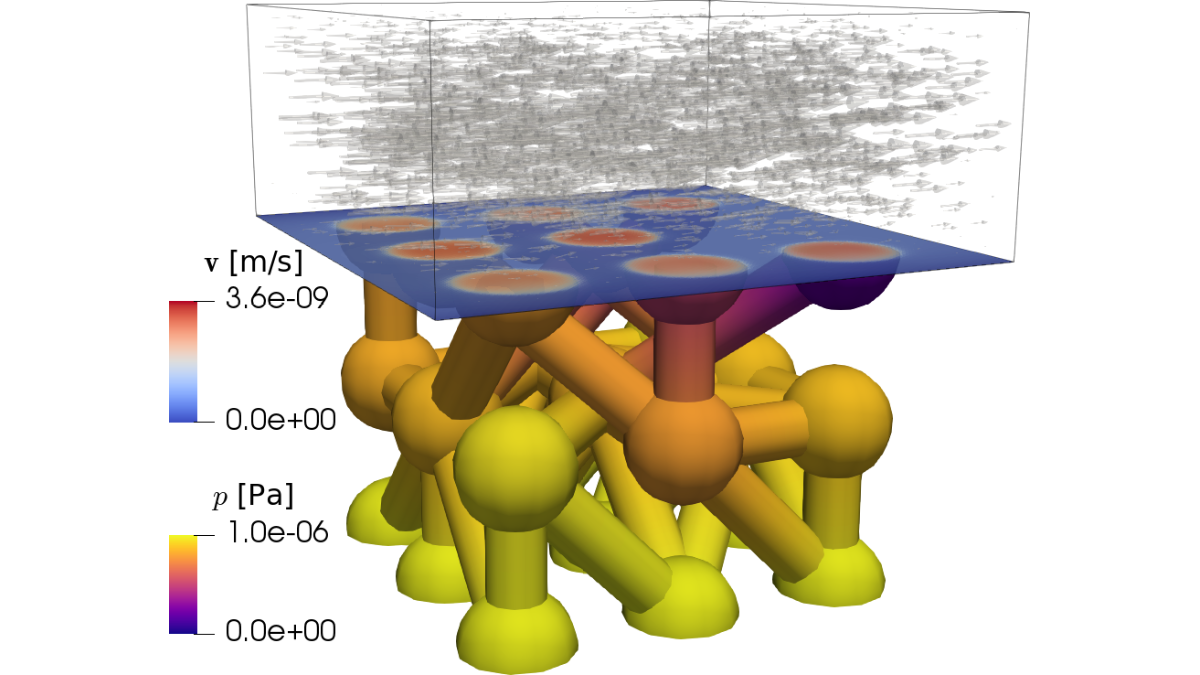People
Johannes Müller
Maziar Veyskarami
Hanchuan Wu
Katharina Heck (Alumna)
Guang Yang (Alumnus)
Kilian Weishaupt (Alumnus, associated member)
Publications
Preprints
- Bursik, B., Stierle, R., Oukili, H., Schneider, M., Bauer, G., & Gross, J. (2025). Modelling Interfacial Dynamics Using Hydrodynamic Density Functional Theory: Dynamic Contact Angles and the Role of Local Viscosity. In arXiv preprint arXiv:2504.03032. https://doi.org/10.48550/arXiv.2504.03032
- Schneider, M., Wu, H., Veyskarami, M., Pop, S., & Helmig, R. (2025). Improvement of fully-implicit two-phase pore-network models by employing generalized flux functions with additional throat variables. In arXiv preprint arXiv:2504.01529. https://doi.org/10.48550/arXiv.2504.01529
- Buntic, I., Schneider, M., Flemisch, B., & Helmig, R. (2024). A fully-implicit solving approach to an adaptive multi-scale model-coupling a vertical-equilibrium and full-dimensional model for compressible, multi-phase flow in porous media. In arXiv preprint arXiv:2405.18285. https://doi.org/10.48550/arXiv.2405.18285
- Wang, W., Zhang, X., Bezgin, D., Buhendwa, A., Chu, X., & Weigand, B. (2024). JAX-based differentiable fluid dynamics on GPU and end-to-end optimization. In arXiv preprint arXiv:2406.19494. https://doi.org/10.48550/arXiv.2406.19494
Conference Papers
- Müller, J., Weigand, B., Wu, H., Schneider, M., & Helmig, R. (2023). Direct Numerical Simulations of turbulent flows over a water saturated porous medium: How two phase pore flow forms roughness at a permeable surface. Proceedings of the InterPore 2023 Conference.
- Chu, X., Müller, J., & Weigand, B. (2021). Interface-Resolved Direct Numerical Simulation of Turbulent Flow over Porous Media. In W. E. Nagel, D. H. Kröner, & M. M. Resch (Eds.), High Performance Computing in Science and Engineering ’19 (pp. 343–354). Springer International Publishing.
- Chu, X., Wang, W., Müller, J., Von Schöning, H., Liu, Y., & Weigand, B. (2021). Turbulence Modulation and Energy Transfer in Turbulent Channel Flow Coupled with One-Side Porous Media. In W. E. Nagel, D. H. Kröner, & M. M. Resch (Eds.), High Performance Computing in Science and Engineering ’20 (pp. 373–386). Springer International Publishing.
- Jaust, A., Weishaupt, K., Mehl, M., & Flemisch, B. (2020). Partitioned coupling schemes for free-flow and porous-media applications with sharp interfaces. In R. Klöfkorn, E. Keilegavlen, F. A. Radu, & J. Fuhrmann (Eds.), Finite Volumes for Complex Applications IX - Methods, Theoretical Aspects, Examples (Vol. 323, pp. 605–613). Springer International Publishing. https://doi.org/10.1007/978-3-030-43651-3_57
- Müller, J., Offenhäuser, P., Reitzle, M., & Weigand, B. (2020). A Method to Reduce Load Imbalances in Simulations of Solidification Processes with Free Surface 3D. In M. M. Resch, Y. Kovalenko, W. Bez, E. Focht, & H. Kobayashi (Eds.), Sustained Simulation Performance 2018 and 2019 (pp. 163–184). Springer International Publishing.
Books
- Köppl, T., & Helmig, R. (2023). Dimension Reduced Modeling of Blood Flow in Large Arteries: An Introduction for Master Students and First Year Doctoral Students. In Mathematical Engineering. Springer International Publishing. https://doi.org/10.1007/978-3-031-33087-2
Journal Articles
- Aricò, C., Helmig, R., & Yotov, I. (2025). Mixed finite element projection methods for the unsteady Stokes equations. Computer Methods in Applied Mechanics and Engineering, 435, 117616. https://doi.org/10.1016/j.cma.2024.117616
- Asbaghi, E. V., Buntic, I., Nazari, F., Flemisch, B., Helmig, R., & Joekar-Niasar, V. (2025). Applicability of the Vertical Equilibrium model to underground hydrogen injection and withdrawal. International Journal of Hydrogen Energy, 106, 790–805. https://doi.org/10.1016/j.ijhydene.2025.01.201
- Coltman, E., Schneider, M., & Helmig, R. (2025). Data-Driven Closure Parametrizations with Metrics: Dispersive Transport. Transport in Porous Media, 152, Article 5. https://doi.org/10.1007/s11242-025-02168-2
- Krach, D., Weinhardt, F., Wang, M., Schneider, M., Class, H., & Steeb, H. (2025). A novel geometry-informed drag term formulation for pseudo-3D Stokes simulations with varying apertures. Advances in Water Resources, 195. https://doi.org/10.1016/j.advwatres.2024.104860
- Yan, L., Müller, J. C., van Noorden, T. L., Weigand, B., & Raoof, A. (2025). Wettability-driven pore-filling instabilities: Microfluidic and numerical insights. Journal of Colloid and Interface Science, 696. https://doi.org/10.1016/j.jcis.2025.137884
- Aricò, C., Helmig, R., Puleo, D., & Schneider, M. (2024). A new numerical mesoscopic scale one-domain approach solver for free fluid/porous medium interaction. Computer Methods in Applied Mechanics and Engineering, 419, 116655. https://doi.org/10.1016/j.cma.2023.116655
- Boon, W. M., Gläser, D., Helmig, R., Weishaupt, K., & Yotov, I. (2024). A mortar method for the coupled Stokes-Darcy problem using the MAC scheme for Stokes and mixed finite elements for Darcy. Computational Geosciences, 28. https://doi.org/10.1007/s10596-023-10267-6
- Jannesarahmadi, S., Aminzadeh, M., Helmig, R., Or, D., & Shokri, N. (2024). Quantifying Salt Crystallization Impact on Evaporation Dynamics From Porous Surfaces. Geophysical Research Letters, 51, Article 22. https://doi.org/10.1029/2024gl111080
- Schneider, J., Kiemle, S., Heck, K., Rothfuss, Y., Braud, I., Helmig, R., & Vanderborght, J. (2024). Analysis of experimental and simulation data of evaporation-driven isotopic fractionation in unsaturated porous media. Vadose Zone Journal, 23, Article 5. https://doi.org/10.1002/vzj2.20363
- Schneider, M., & Koch, T. (2024). Stable and locally mass- and momentum-conservative control-volume finite-element schemes for the Stokes problem. Computer Methods in Applied Mechanics and Engineering, 420. https://doi.org/10.1016/j.cma.2023.116723
- Schollenberger, T., von Wolff, L., Bringedal, C., Pop, I. S., Rohde, C., & Helmig, R. (2024). Investigation of Different Throat Concepts for Precipitation Processes in Saturated Pore-Network Models. Transport in Porous Media, 151, Article 14. https://doi.org/10.1007/s11242-024-02125-5
- Veyskarami, M., Bringedal, C., & Helmig, R. (2024). Modeling and Analysis of Droplet Evaporation at the Interface of a Coupled Free-Flow-Porous Medium System. Transport in Porous Media, 151. https://doi.org/10.1007/s11242-024-02123-7
- Ackermann, S., Fest-Santini, S., Veyskarami, M., Helmig, R., & Santini, M. (2023). Experimental validation of a coupling concept for drop formation and growth onto porous materials by high-resolution X-ray imaging technique. International Journal of Multiphase Flow, 160, 104371. https://doi.org/10.1016/j.ijmultiphaseflow.2022.104371
- Boon, W. M., Gläser, D., Helmig, R., & Yotov, I. (2023). Flux-mortar mixed finite element methods with multipoint flux approximation. Computer Methods in Applied Mechanics and Engineering, 405, 115870. https://doi.org/10.1016/j.cma.2022.115870
- Härter, J., Martínez, D. S., Poser, R., Weigand, B., & Lamanna, G. (2023). Coupling between a turbulent outer flow and an adjacent porous medium: High resolved Particle Image Velocimetry measurements. Physics of Fluids, 35, Article 2. https://doi.org/10.1063/5.0132193
- Kiemle, S., Heck, K., Coltman, E., & Helmig, R. (2023). Stable Water Isotopologue Fractionation During Soil-Water Evaporation: Analysis Using a Coupled Soil-Atmosphere Model. Water Resources Research, 59, Article 2. https://doi.org/10.1029/2022wr032385
- Mohammadi, F., Eggenweiler, E., Flemisch, B., Oladyshkin, S., Rybak, I., Schneider, M., & Weishaupt, K. (2023). A surrogate-assisted uncertainty-aware Bayesian validation framework and its application to coupling free flow and porous-medium flow. Computational Geosciences, 27. https://doi.org/10.1007/s10596-023-10228-z
- Schneider, M., Glaeser, D., Weishaupt, K., Coltman, E., Flemisch, B., & Helmig, R. (2023). Coupling staggered-grid and vertex-centered finite-volume methods for coupled porous-medium free-flow problems. Journal of Computational Physics, 482. https://doi.org/10.1016/j.jcp.2023.112042
- Tatomir, A., Gao, H., Abdullah, H., Pötzl, C., Karadimitriou, N., Steeb, H., Licha, T., Class, H., Helmig, R., & Sauter, M. (2023). Estimation of Capillary-Associated NAPL-Water Interfacial Areas for Unconsolidated Porous Media by Kinetic Interface Sensitive (KIS) Tracer Method. Water Resources Research, 59, Article 12. https://doi.org/10.1029/2023WR035387
- Veyskarami, M., Michalkowski, C., Bringedal, C., & Helmig, R. (2023). Droplet Formation, Growth and Detachment at the Interface of a Coupled Free-Flow-Porous Medium System: A New Model Development and Comparison. Transport in Porous Media, 149. https://doi.org/10.1007/s11242-023-01944-2
- Wu, H., Veyskarami, M., Schneider, M., & Helmig, R. (2023). A New Fully Implicit Two-Phase Pore-Network Model by Utilizing Regularization Strategies. Transport in Porous Media, 151. https://doi.org/10.1007/s11242-023-02031-2
- Ahmadi, N., Muniruzzaman, M., Sprocati, R., Heck, K., Mosthaf, K., & Rolle, M. (2022). Coupling soil/atmosphere interactions and geochemical processes: A multiphase and multicomponent reactive transport approach. Advances in Water Resources, 169, 104303. https://doi.org/10.1016/j.advwatres.2022.104303
- Boon, W. M., Gläser, D., Helmig, R., & Yotov, I. (2022). Flux-Mortar Mixed Finite Element Methods on Non-Matching Grids. SIAM Journal on Numerical Analysis, 60, Article 3. https://doi.org/10.1137/20M1361407
- Bringedal, C., Schollenberger, T., Pieters, G. J. M., van Duijn, C. J., & Helmig, R. (2022). Evaporation-Driven Density Instabilities in Saturated Porous Media. Transport in Porous Media, 143, Article 2. https://doi.org/10.1007/s11242-022-01772-w
- Eller, J., Sauerborn, T., Becker, B., Buntic, I., Gross, J., & Helmig, R. (2022). Modeling Subsurface Hydrogen Storage With Transport Properties From Entropy Scaling Using the PC-SAFT Equation of State. Water Resources Research, 58, Article 4. https://doi.org/10.1029/2021WR030885
- Gläser, D., Schneider, M., Flemisch, B., & Helmig, R. (2022). Comparison of cell- and vertex-centered finite-volume schemes for flow in fractured porous media. Journal of Computational Physics, 448. https://doi.org/10.1016/j.jcp.2021.110715
- Michalkowski, C., Veyskarami, M., Bringedal, C., Helmig, R., & Schleper, V. (2022). Two-phase Flow Dynamics at the Interface Between GDL and Gas Distributor Channel Using a Pore-Network Model. Transport in Porous Media, 144, Article 2. https://doi.org/10.1007/s11242-022-01813-4
- Michalkowski, C., Weishaupt, K., Schleper, V., & Helmig, R. (2022). Modeling of two phase flow in a hydrophobic porous medium interacting with a hydrophilic structure. Transport in Porous Media, 144, Article 2. https://doi.org/10.1007/s11242-022-01816-1
- Tsinober, A., Rosenzweig, R., Class, H., Helmig, R., & Shavit, U. (2022). The Role of Mixed Convection and Hydrodynamic Dispersion During CO2 Dissolution in Saline Aquifers: A Numerical Study. Water Resources Research, 58, Article 3. https://doi.org/10.1029/2021WR030494
- Wang, W., Lozano-Durán, A., Helmig, R., & Chu, X. (2022). Spatial and spectral characteristics of information flux between turbulent boundary layers and porous media. Journal of Fluid Mechanics, 949. https://doi.org/10.1017/jfm.2022.770
- Weishaupt, K., Koch, T., & Helmig, R. (2022). A fully implicit coupled pore-network/free-flow model for the pore-scale simulation of drying processes. Drying Technology, 40, Article 4. https://doi.org/10.1080/07373937.2021.1955706
- Younes, A., Hoteit, H., Helmig, R., & Fahs, M. (2022). A robust upwind mixed hybrid finite element method for transport in variably saturated porous media. Hydrology and Earth System Sciences, 26, Article 20. https://doi.org/10.5194/hess-26-5227-2022
- Younes, A., Hoteit, H., Helmig, R., & Fahs, M. (2022). A robust fully mixed finite element model for flow and transport in unsaturated fractured porous media. Advances in Water Resources, 166. https://doi.org/10.1016/j.advwatres.2022.104259
- Ahmadi, N., Heck, K., Rolle, M., Helmig, R., & Mosthaf, K. (2021). On multicomponent gas diffusion and coupling concepts for porous media and free flow: a benchmark study. Computational Geosciences. https://doi.org/10.1007/s10596-021-10057-y
- Haide, R., Fest-Santini, S., & Santini, M. (2021). Use of X-ray micro-computed tomography for the investigation of drying processes in porous media: A review. Drying Technology, 1–14. https://doi.org/10.1080/07373937.2021.1876723
- Koch, T., Gläser, D., Weishaupt, K., Ackermann, S., Beck, M., Becker, B., Burbulla, S., Class, H., Coltman, E., Emmert, S., Fetzer, T., Grüninger, C., Heck, K., Hommel, J., Kurz, T., Lipp, M., Mohammadi, F., Scherrer, S., Schneider, M., et al. (2021). DuMux 3 - an open-source simulator for solving flow and transport problems in porous media with a focus on model coupling. Computers & Mathematics with Applications, 81, 423–443. https://doi.org/10.1016/j.camwa.2020.02.012
- Koch, T., Weishaupt, K., Müller, J., Weigand, B., & Helmig, R. (2021). A (Dual) Network Model for Heat Transfer in Porous Media. Transport in Porous Media. https://doi.org/10.1007/s11242-021-01602-5
- Wang, W., Chu, X., Lozano-Durán, A., Helmig, R., & Weigand, B. (2021). Information transfer between turbulent boundary layers and porous media. Journal of Fluid Mechanics, 920. https://doi.org/10.1017/jfm.2021.445
- Wang, Wenkang (王文康), Yang, Guang (杨光), Evrim, C., Terzis, A., Helmig, R., & Chu, Xu (初旭). (2021). An assessment of turbulence transportation near regular and random permeable interfaces. Physics of Fluids, 33, Article 11. https://doi.org/10.1063/5.0069311
- Weishaupt, K., & Helmig, R. (2021). A dynamic and fully implicit non-isothermal, two-phase, two-component pore-network model coupled to single-phase free flow for the pore-scale description of evaporation processes. Water Resources Research. https://doi.org/10.1029/2020wr028772
- Bahlmann, L. M., Smits, K., Heck, K., Coltman, E., Helmig, R., & Neuweiler, I. (2020). Gas Component Transport across the Soil-Atmosphere-Interface for Gases of Different Density: Experiments and Modeling. Water Resources Research. https://doi.org/10.1029/2020wr027600
- Chu, X., Wang, W., Yang, G., Terzis, A., Helmig, R., & Weigand, B. (2020). Transport of Turbulence Across Permeable Interface in a Turbulent Channel Flow: Interface-Resolved Direct Numerical Simulation. Transport in Porous Media. https://doi.org/10.1007/s11242-020-01506-w
- Chu, X., Wu, Y., Rist, U., & Weigand, B. (2020). Instability and transition in an elementary porous medium. Phys. Rev. Fluids, 5, Article 4. https://doi.org/10.1103/PhysRevFluids.5.044304
- de Winter, D. A. M., Weishaupt, K., Scheller, S., Frey, S., Raoof, A., Hassanizadeh, S. M., & Helmig, R. (2020). The Complexity of Porous Media Flow Characterized in a Microfluidic Model Based on Confocal Laser Scanning Microscopy and Micro-PIV. Transport in Porous Media, 136, 343–367. https://doi.org/10.1007/s11242-020-01515-9
- Heck, K., Coltman, E., Schneider, J., & Helmig, R. (2020). Influence of Radiation on Evaporation Rates: A Numerical Analysis. Water Resources Research, 56, Article 10. https://doi.org/10.1029/2020wr027332
- Schneider, M., Weishaupt, K., Gläser, D., Boon, W. M., & Helmig, R. (2020). Coupling staggered-grid and MPFA finite volume methods for free flow/porous-medium flow problems. Journal of Computational Physics, 401. https://doi.org/10.1016/j.jcp.2019.109012
- Schout, G., Hartog, N., Hassanizadeh, S. M., Helmig, R., & Griffioen, J. (2020). Impact of groundwater flow on methane gas migration and retention in unconsolidated aquifers. Journal of Contaminant Hydrology, 230, 103619. https://doi.org/10.1016/j.jconhyd.2020.103619
- Weishaupt, K., Terzis, A., Zarikos, I., Yang, G., Flemisch, B., de Winter, D. A. M., & Helmig, R. (2020). A Hybrid-Dimensional Coupled Pore-Network/Free-Flow Model Including Pore-Scale Slip and Its Application to a Micromodel Experiment. Transport in Porous Media. https://doi.org/10.1007/s11242-020-01477-y
- Chu, X., Yang, G., Pandey, S., & Weigand, B. (2019). Direct numerical simulation of convective heat transfer in porous media. International Journal of Heat and Mass Transfer, 133, 11–20. https://doi.org/10.1016/j.ijheatmasstransfer.2018.11.172
- Terzis, A., Zarikos, I., Weishaupt, K., Yang, G., Chu, X., Helmig, R., & Weigand, B. (2019). Microscopic velocity field measurements inside a regular porous medium adjacent to a low Reynolds number channel flow. Physics of Fluids, 31, Article 4. https://doi.org/10.1063/1.5092169
- Weishaupt, K., Joekar-Niasar, V., & Helmig, R. (2019). An efficient coupling of free flow and porous media flow using the pore-network modeling approach. Journal of Computational Physics: X, 1. https://doi.org/10.1016/j.jcpx.2019.100011
- Yang, G., Terzis, A., Zarikos, I., Hassanizadeh, S. M., Weigand, B., & Helmig, R. (2019). Internal flow patterns of a droplet pinned to the hydrophobic surfaces of a confined microchannel using micro-PIV and VOF simulations. Chemical Engineering Journal, 370, 444–454. https://doi.org/10.1016/j.cej.2019.03.191
- Yang, G., Vaikuntanathan, V., Terzis, A., Cheng, X., Weigand, B., & Helmig, R. (2019). Impact of a Linear Array of Hydrophilic and Superhydrophobic Spheres on a Deep Water Pool. Colloids Interfaces, 3, Article 1. https://doi.org/10.3390/colloids3010029
- Chu, X., Weigand, B., & Vaikuntanathan, V. (2018). Flow turbulence topology in regular porous media: From macroscopic to microscopic scale with direct numerical simulation. Physics of Fluids, 30, Article 6. https://doi.org/10.1063/1.5030651
- Sauer, E., Terzis, A., Theiss, M., Weigand, B., & Gross, J. (2018). Prediction of Contact Angles and Density Profiles of Sessile Droplets Using Classical Density Functional Theory Based on the PCP-SAFT Equation of State. Langmuir, 34, Article 42. https://doi.org/10.1021/acs.langmuir.8b01985
- Yang, G., Weigand, B., Terzis, A., Weishaupt, K., & Helmig, R. (2018). Numerical Simulation of Turbulent Flow and Heat Transfer in a Three-Dimensional Channel Coupled with Flow Through Porous Structures. Transport in Porous Media, 122, Article 1. https://doi.org/10.1007/s11242-017-0995-9
Published data sets
- Bringedal, C. (2025). Netgen/NGSolve code for pore-resolved simulations for: Local Thermal Non-Equilibrium Models in Porous Media: A Comparative Study of Conduction effects [DaRUS]. https://doi.org/10.18419/DARUS-4771
- Kostelecky, A. M. (2025). Replication Data for: Local Thermal Non-Equilibrium Models in Porous Media: A Comparative Study of Conduction effects [DaRUS]. https://doi.org/10.18419/DARUS-4782
- Kostelecky, A. M. (2025). DuMuX code for dual network for: Local Thermal Non-Equilibrium Models in Porous Media: A Comparative Study of Conduction effects [DaRUS]. https://doi.org/10.18419/DARUS-4781
- Müller, J., Yan, L., Raoof, A., & Weigand, B. (2025). Microfluidic experiments on single pore-filling instabilities with varying wettability, capillary number and viscosity ratio [DaRUS]. https://doi.org/10.18419/DARUS-4683
- Stefansson, I. (2025). PorePy code for REV simulations for: Local Thermal Non-Equilibrium Models in Porous Media: A Comparative Study of Conduction effects [DaRUS]. https://doi.org/10.18419/DARUS-4785
- Gläser, D. (2024). Dumux code for Stokes-Darcy mortar method [DaRUS]. https://doi.org/10.18419/DARUS-3598
- Gläser, D. (2024). Results for Stokes-Darcy mortar method [DaRUS]. https://doi.org/10.18419/DARUS-3599
- Kiemle, S., & Heck, K. (2024). Dumux code for modelling stable water isotopologue transport within soils using fractionation parameterizations [DaRUS]. https://doi.org/10.18419/DARUS-3330
- Kiemle, S., Schneider, J., & Heck, K. (2024). Replication data for analyzing stable water isotopologue transport within soils using fractionation parameterizations [DaRUS]. https://doi.org/10.18419/DARUS-3572
- Lipp, M. (2024). Data for: Capturing local details in fluid-flow simulations: options, challenges and applications using marker-and-cell schemes [DaRUS]. https://doi.org/10.18419/DARUS-4183
- Schneider, J., Braud, I., Rothfuss, Y., & Vanderborght, J. (2024). SiSPAT-Isotope code for modelling stable water isotopologue transport within soils [DaRUS]. https://doi.org/10.18419/DARUS-3595
- Gläser, D. (2023). Dumux Code for flux-mortar method with mpfa [DaRUS]. https://doi.org/10.18419/DARUS-3257
- Gläser, D. (2023). Results for flux-mortar method with mpfa [DaRUS]. https://doi.org/10.18419/DARUS-3261
- Kiemle, S., & Heck, K. (2022). Dumux code for modelling stable water isotopologue transport and fractionation [DaRUS]. https://doi.org/10.18419/DARUS-3105
- Kiemle, S., & Heck, K. (2022). Data set for reproducing plots showing stable water isotopologue transport and fractionation [DaRUS]. https://doi.org/10.18419/DARUS-3108
- Schollenberger, T., & Helmig, R. (2022). Replication Data for the numerical simulations in: Evaporation-driven density instabilities in saturated porous media [DaRUS]. https://doi.org/10.18419/DARUS-2578
- Jaust, A., Weishaupt, K., Flemisch, B., & Schulte, M. (2021). Replication Data for: Partitioned coupling schemes for free-flow and porous-media applications with sharp interfaces [DaRUS]. https://doi.org/10.18419/DARUS-1644
- Koch, T., & Weishaupt, K. (2021). Dumux code for creating results in dual network publication [DaRUS]. https://doi.org/10.18419/DARUS-1825
Research
About this Project
Exchange processes across a porous-medium free-flow interface occur in a wide range of environmental, technical and bio-mechanical systems. The primary objectives of this project are to (i) analyse and improve the theory, as well as (ii) offer solution methods for non-isothermal, multi-phase, multi-component flow and transport processes at a porous-medium free-flow interface and (iii) investigate the influence of these processes on both the porous medium and free-flow region for various application scales.
Results
Funding Period 1
The challenge of including scale-dependent, interface-driven processes into mathematical and numerical models for systems of coupled free flow and porous-medium flow is the primary object of research of project A02. We found that existing models usually operate on either the pore scale or on the REV scale which has the following drawbacks: pore-scale models provide a detailed physical insight into various types of processes but their prohibitively high computational demand makes them only applicable to relatively small domains. On the other hand, the higher degree of computational efficiency provided by REV-scale models comes at the price of losing potentially process-relevant sub-scale information. In addition, several assumptions and simplifications commonly involved in REV-scale modelling can only be justified for a limited range of applications and flow conditions.
Our main goal is the development of new model concepts combining the strengths of both pore-scale and REV-scale approaches.
During the first funding period (FP1), we laid the foundations for the development of these cross-scale concepts. A new hybrid modelling approach was developed to account for pore-scale processes in the interface-region. These are considered by a pore-network model (PNM) that couples the REV domain with the free-flow domain.
We developed interface conditions for the coupling between the free-flow domain and the pore-network model, ensuring the conservation mass and momentum across the discrete pore-scale coupling interface. Following this, conditions for coupling the pore-network model with the REV-scale bulk porous medium were developed, resulting in a three-domain model concept where the pore-network models serves as an interface region between the free-flow domain and the bulk porous part. The coupled free-flow/pore network model was extended for non-isothermal, multi-component two-phase flow in the network part, allowing the simulation of an evaporation process in ample detail.
To obtain the unknown coupling paramters comprised in the coupling condtions the interface exchange processes have been investigated with pore-resolved direct numerical simulations (DNS) resolving all relevant time and length scales in the pore-space complemented by pore-scale experimental data provided by our collaboration partners at Utrecht University.
Funding Period 2
In the second funding period (FP2), the influence of surface roughness at the pore-scale and surface topology at the macro-scale of permeable surfaces including multiphase systems was analysed. This allowed detailed physical insights into the interaction between the porous medium and the external free-flow and enabled the improvement of the efficient hybrid modeling approach that can now be used for the efficient modeling of such systems. This was achieved by introducing coupling conditions for arbitrary flow conditions developed in A03.
To further improve the PNM as the key part in the hybrid modeling approach a novel, fully implicit PNM with increased robustness, efficiency and accuracy for non-isothermal multi-component multiphase systems was developed. Building on this, a dual pore-network model (DPNM) was developed to capture the conjugate heat transfer between solid and fluid phases.
With respect to the pore-local closure relations used by the PNM which are used to bride the scale gap from fully resolved pore space to single discretization points per pore, pore resolved simulations have been condcted. This enabled us to create a dataset for new pore-local capillary pressure-saturation relations, dependend on intrinsic wettability, viscosity ratio and capillary number. The quantitative data was compared to experimental data form our eternal partners at Utrecht University and showed the limitations of classical pore-local relations used in pore-network models (PNMs).
To improve the REV-scale modelling also comprised in the hybrid modeling approach an upscaling from the pore-scale to the REV-scale was developped.
Future Work
The overall aim of FP3 is to accurately describe the evaporation process in the interfacial region on the one hand and possible precipitation processes of salt on the other. Therefore, the existing evaporation model in our DNS framework will be extended to accurately capture the evaporation processes in the vicinity of three-phase contact lines. This will allow us to continue our strategy of performing pore-resolved simulations that resolve all relevant time and length scales and use them to develop the necessary coupling conditions for the cross-scale hybrid modelling concept and to provide the required effective parameters for the REV-scale models. Here we will collaborate with research project A03 to develop new coupling conditions that account for changes in liquid distribution during evaporation. To quantify their dependencies on sub-scale characteristics, such as pore geometry and liquid distribution, we continue our work with D03-Flemisch/Oladyshkin and develop a corresponding surrogate model. The verification of the selected coupling approaches for the evaporation process will be compared with the pore-resolved simulations and with experiments.
The developed dynamic PNM enables an implicit solution of two-phase flow, accounting for pore space evolution and pore constriction due to salt precipitation. This advancement enhances our ability to predict drying and salt deposition patterns, supporting the goals of the vision project.
International Cooperation
Validation of drying and salt precipitation patterns with experimental data
The drying and salt precipitation patterns obtained from a quasi-static pore-network model (PNM) are first compared with those from a dynamic PNM. To ensure accuracy, we validate than our models against microfluidic experiments conducted by PML (Z02-Karadimitriou/Steeb) in collaboration with Bo Guo’s team at the University of Arizona.
For further information please contact

Rainer Helmig
Prof. Dr.-Ing. Dr.-Ing. h.c.Project Leader, Former Spokesperson, Research Projects A02, A05, and C02

Bernhard Weigand
Prof. Dr.-Ing. habil.Project Leader, Research Project A02





